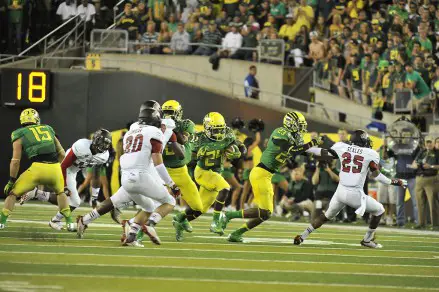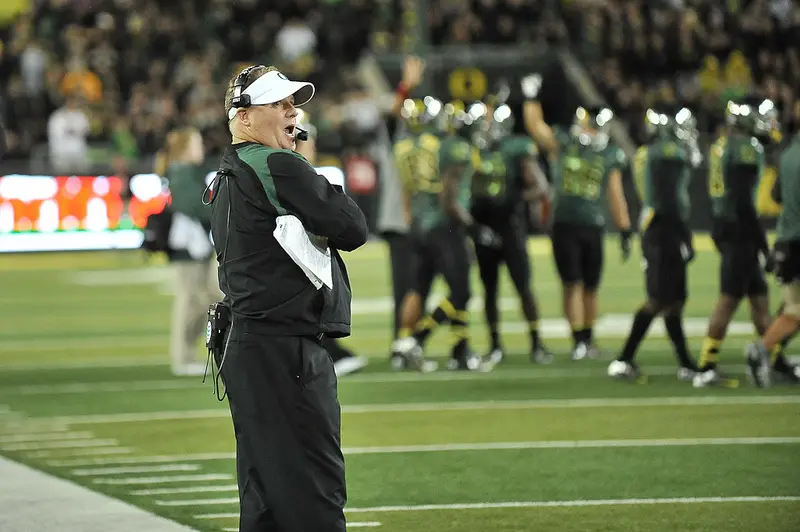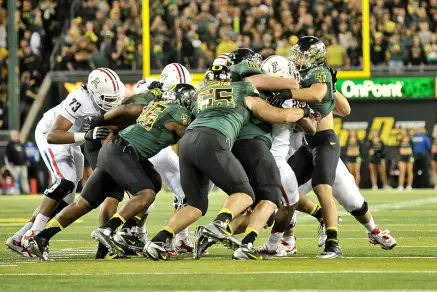Leading up to the kickoff against Nicholls State, Duck fans were anxious to see what Oregon would look like under new coach Mark Helfrich. Chip Kelly had led the program to previously unprecedented heights, and had done so using a unique and distinctive approach. His trademark spread option attack put up staggering stats, and routinely churned out over 300 yards per game rushing, while scoring more points than ever before.
After Chip left to become the head coach in Philadelphia, many sided with the popular opinion: it would be crazy to change much, if anything, from the formula that had taken the Ducks to four straight BCS bowls.
From the blatant disregard of time of possession, the playbook being used, the in-game play calling, to music selections in practice — the routine was far from broken. So why would anyone change it?
It was reasonable to predict a downturn in rushing production in 2013. First and foremost was losing the 1-2 punch of LaMichael James and Kenjon Barner in consecutive seasons — both of whom are currently on NFL playoff teams — would be difficult to replace. Combine that with the fact that new head coach Helfrich and new offensive coordinator Scott Frost were both ex-quarterbacks, perhaps Oregon would stray from the run game that had made up 65% of the offense under Kelly.
They would instead lean on more the outstanding accuracy of Marcus Mariota and throw the ball more often. Recent recruiting successes and hiring a nationally acclaimed receivers coach in Matt Lubick from Duke to coach them, seemed to solidify a new emphasis in the passing game.
On the defense, expectations were high for one of the deepest groups of defensive lineman in recent history and a crew of proven playmakers as defensive backs, but the linebackers were going to be a bit of a question. After all, the team had lost it’s two leading tacklers in Michael Clay and Kiko Alonso, and also veteran sack specialist and team leader Dion Jordan. Few, if anyone, knew it would also be the final season for long time defensive coordinator Nick Aliotti.
So how did the preseason questions get answered? With all of games now in the books, let’s take a look back at four areas that both shaped 2013 for the Big Green football team, while also breaking the mold of previous seasons.
Airing it out
Whether it was by design, due to personnel changes or determined by the defenses they faced, Oregon indeed threw more passes in Mark Helfrich’s first season than they ever did under Chip Kelly. A look at Mariota’s season stats shows the difference that led to breaking multiple school and conference records in passing categories.
2013: Mariota – 245/386, 3665 yds, 63.5%, 9.5 y/a, 31 TD, 4 INT, 167.7 rating. Passing accounted for 41% of offensive plays.
2012: Mariota – 230/336, 2677 yds, 68.5%, 7.97 y/a, 32 TD, 6 INT, 163.3 rating. Passing accounted for 35% of offensive plays.
The 2013 team was effective running the ball, as a team they rushed for 6.3 yards/att and 3,556 total yards. Led by Byron Marshall’s 1,038 yards and 14 TD, the three primary backs, including DAT (594 yds, 8 TD) and Tyner (711 yds, 9 TD), all rushed for an identical 6.2 yards per carry, and Mariota added 715 yards and 9 TD. While Oregon distributed the load more evenly this season, Oregon rushed for far less than in 2012, when they racked up 4,098 yards and 48 TD.

The Ducks lost both of their all-time rushers in Kenjon Barner and LaMichael James in back to back seasons.
As a result, Oregon also had their most yards in a season from a wide receiver ever in Josh Huff who caught 62 passes for 1,140 yards and 12 TD.
Teammate Bralon Addison had 61 receptions for 890 yards and 7 TD, both becoming the first and second receivers since Jeff Maehl to have more than 500 receiving yards in a season.
Yards Per Play
While total yards were most all time, and yards per play were almost a full yard more in 2013, touchdowns and number of plays regressed.
Year YPP TYds Plays (Pass/Rush) TD
2013 7.54 7,345 973 (3,789 / 3,556) 74 TD)
2012 6.60 6,986 1,058 (2,888 / 4,098) 83 TD)
2011 7.21 7,319 1,015 (3,130 / 4,189) 81 TD)
2010 6.73 6,899 1,024 (3,178 / 3,721) 73 TD)
2009 6.05 5,356 885 (2,344 / 3,012) 54 TD)
Turnovers
Overall, the Ducks had more turnovers than any of the previous three seasons, and forced opponents into far fewer than last season. The 6 interceptions (4 by Mariota) in 2013 are a four-season low, but the 30 fumbles is far too many, even if five or six of them came during a monsoon vs Cal.
2013 Ducks: 6 int 30 fum – 36 total / Opp: 17 int 22 fum – 39 total
2012 Ducks: 9 int 27 fum – 35 total / Opp: 25 int 25 fum – 50 total
2011 Ducks: 7 int 24 fum – 31 total / Opp: 17 int 23 fum – 40 total
2010 Ducks: 9 int 26 fum – 35 total / Opp: 21 int 26 fum – 46 total
Tackles For Loss
The aforementioned departing linebacker trio of Michael Clay, Dion Jordan, and Kiko Alonso combined for 34.5 tackles for loss in 2012. Taylor Hart and his 11 TFL would be back in 2013, but no other Ducks had posted more than Boseko Lokombo’s 4.5. As a team, the 2012 Ducks listed 83 tackles for loss and 28 sacks.
In 2013, Oregon managed to replace the 28 sacks, but the tackles for loss dipped to 70, or one fewer per game. The 2010 team that played in the BCS National Championship game had 97 tackles for loss, the 2011 defense had 45 sacks. While a one-per-game average may not seem overwhelming, opposing teams were given 232 opportunities to convert third downs this year compared to 196 in 2012. That one extra tackle for loss could have been the difference between a 3rd-and-1 versus a 3rd-and-long, giving the defense more chances to get off the field in crucial situations.
In all, the Ducks showed change this season, and change isn’t always bad. While this year’s team improved in some areas, there are so many areas in which they can rachet things up on offense and defense, even including other important details, like finding a way to reduce a head-sctratching 106 penalties.
If Oregon maintains a balanced attack and can improve in a few key areas in the second season under Mark Helfrich, the Ducks have a good chance to carry on the unstoppable reputation that was earned under Chip Kelly.
Top Photo by Kevin Cline
Related Articles:
Chip Kelly Update: Everything's Good Again ...
Chip Kelly Update: Wailing and Gnashing of Teeth
Shock and Awe -- The Oregon Ducks' Football Hangover Effect
Despite Lopsided Score, Georgia State "Never Stopped Believing"
Hope Springs Eternal for Ducks
Incompetent Pac-12 Officials: How Do You Miss ALL of THIS?
Josh White has been a dedicated Duck fan since the Bill Musgrave days. He has attended (and lost his voice at) virtually every home game and many away games since the late 1980’s, including 96 of the current 97 game sellout streak at Autzen Stadium. A Eugene native, Josh works full time in Eugene area real estate, helping people buy and sell residential and commercial properties, and also volunteers with Habitat For Humanity, Kidsports and Food For Lane County. He welcomes your feedback.
Twitter: @WhiteHouseJosh
Facebook: EugenesBestRealtor


